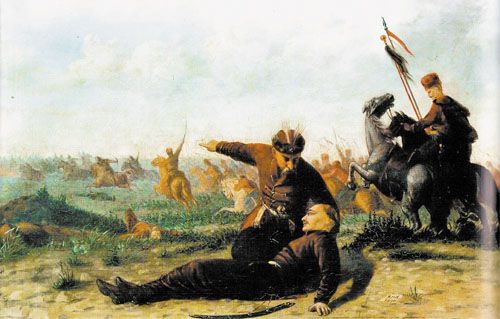Ukrainian life in academic paintings by Kornylo Ustyianovych
Painter created a unique series of portraits of cultural figures who were active in Galicia in the late 19th century
Kornylo Ustyianovych, son of a Galician priest, Ukrainian Russophile writer and public figure, one of the founders and leaders of the “Enlightenment” society Mykola Ustyianovych, was born on September 22, 1839 in the village of Vovche near Lviv. After graduating from Lviv Gymnasium in 1858 he entered the Academy of Fine Arts in Vienna, where his teachers at the Department of Historic Painting were such renowned artists as Christian Ruben, Joseph Fuehrich, and Carl Wurzinger.
Although the new trends of romanticism and realism actively manifested themselves in artistic life of many European countries, academism in Austria, which had already started to move away into the past, still retained its authority. The reality was not considered worthy of portraying in art from the perspective of the academism. Elevating the cult of ideal beauty the academic artists were looking for themes in mythology, religion, and ancient history, art techniques expressed idealized forms, in semi-theatrical gestures and poses, in fanciful colors. Such spirit, detached from real life, prevailed at the Vienna Academy at the time, when young Kyrylo Ustyianovych came there with a sincere desire to receive art education.
Despite the difficulty of academic tasks, the future artist attended lectures on art history at the University of Vienna as an auditor, where he met with Peter Geiger, whose art work stood out the artistic heritage of academic professors. During his training young Ustyianovych evolved from the ideas of Pan-Slavism and Russophilia (origins of which he took from his family home and developed in Vienna under the influence of Russian priest Mikhail Raevsky) to active Ukrainian patriotism, which was influenced by active communication with Polish patriots – writer Bronislaw Zaleski and artists Artur Grottger and A.Grotowski.
After completing his studies he travelled across Galicia and Bukovyna, observing the everyday life of people, and visited Saint Petersburg (1867) and Kyiv (1872).
The artistic works of Ustyianovych are multifaceted. In 40 years, he painted 15 iconostases and produced 11 mural paintings and a large number of icons for over 50 churches. He created a series of paintings on biblical topics: Christ before Pilate (1880, Vienna), Moses (1887, in the Transfiguration Church in Lviv), Baptism of Rus’, Volodymyr the Great and Saint Olha (1890, in the Vistova village church, near Kalush). He also touched upon historical themes in Cossack Battle (1890) and Shevchenko in Exile (early 1890s).
Ustyianovych created a unique series of portraits of cultural figures who were active in Galicia in the late 19th century – Tyt Revakovych, Porfyrii Bazhansky, Anatol Vakhnianyn, Yuliian Lavrivsky, I. Savchynska and others. The portraits reveal a gradual transition from the traditions of classicism and academism to the new trends of romanticism. Ustyianovych was one of the first Western Ukrainian painters to turn to painting scenes from everyday life as he depicted the residents of the Carpathian area.
As a poet and writer, Ustyianovych debuted in 1861 with poetry written in yazychiie (an artificial bookish language used in Western Ukraine at the turn of the 20th century. Later, in the 1870s, under the influence of Ukrainian writers he published a number of poems and dramas – Sviatoslav Khorobry (Sviatoslav the Brave), Yaropolk and Oleh Sviatoslavovych – written in literary Ukrainian. In 1882-83, he illustrated and edited the satirical magazine Zerkalo.
Ustyianovych died in July 1903 in the village of Dovhe near Drohobych while working on an iconostasis for a village church.
In the history of Ukrainian culture, Ustyianovych is known primarily as a painter representing the academic, classic strand in Galician art. Ivan Franko described the literary and painting activity of Ustyianovych and gave priority to his talent as a painter. In essence, he was as significant for the development of Ukrainian art in Galicia in the second half of the 19th century as the Ruthenian Triad was for Western Ukrainian literature in that entire century.
A small book about the life and artistic pursuits of Ustyianovych was written by Lviv-based art critic Yaroslav Nanovsky and published in 1963. Finally, 50 years later, on April 23, 2013, the public was presented with a nicely printed catalogue raisonne of his paintings, drawings and manuscripts held by the Andrei Sheptytsky National Museum in Lviv. The author and compiler is Oksana Zheplynska, a long-time employee of the museum. The catalogue is set to become an indispensable tool for discovering new dimensions in the multifarious artistic activity of Kornylo Ustyianovych.






